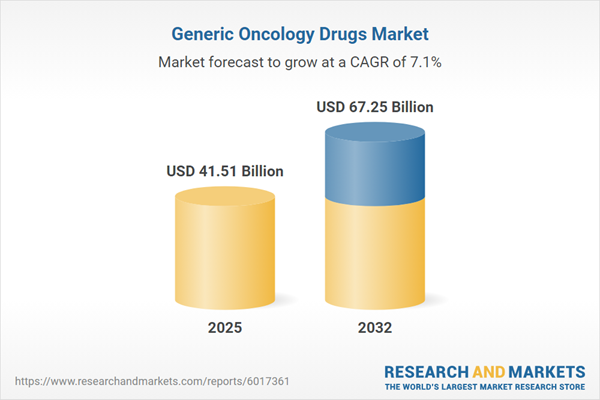Speak directly to the analyst to clarify any post sales queries you may have.
Generic oncology drugs are rapidly reshaping cancer care access and affordability worldwide. Market leaders now face an evolving landscape characterized by intensifying competition, shifting regulatory priorities, and new technological imperatives that require swift adaptation and strategic foresight.
Market Snapshot: Generic Oncology Drugs Market
The Generic Oncology Drugs Market grew from USD 38.74 billion in 2024 to USD 41.51 billion in 2025. It is expected to continue growing at a CAGR of 7.13%, reaching USD 67.25 billion by 2032. Senior executives must recognize that continued double-digit expansion underscores the importance of agile supply chains, innovation in manufacturing, and global regulatory harmonization across the value chain.
Scope & Segmentation
This research provides a comprehensive analysis of the competitive and developmental dynamics shaping generic oncology therapeutics globally. The following segmentation highlights how various categories drive strategic differentiation and operational complexity:
- Drug Type: Small Molecule, Biologics
- Indication: Breast Cancer, Colorectal Cancer, Leukemia, Lung Cancer, Lymphoma, Prostate Cancer
- Distribution Channel: Hospital Pharmacies, Online Pharmacies, Retail Pharmacies
- Route of Administration: Intravenous, Oral, Subcutaneous
- Therapy Line: First-Line, Second-Line, Third-Line Plus
- Mechanism of Action: Chemotherapy, Immunotherapy including CAR-T Therapy and Checkpoint Inhibitors, Targeted Therapy including Monoclonal Antibodies and Tyrosine Kinase Inhibitors
- Formulation: Liquid, Lyophilized Powder, Tablet
- Regions Covered: Americas (including North America and Latin America), Europe, Middle East & Africa, Asia-Pacific
- Key Companies: Teva Pharmaceutical Industries Ltd, Sandoz International GmbH, Pfizer Inc, Fresenius Kabi AG, Hikma Pharmaceuticals PLC, Viatris Inc, Dr. Reddy’s Laboratories Ltd, Aurobindo Pharma Limited, Sun Pharmaceutical Industries Limited, Cipla Limited
Generic Oncology Drugs Market: Key Insights
- Patent expirations and reference product exclusivity losses are intensifying competition, prompting rapid generic entry across high-profile oncology drug classes.
- Regulatory bodies have created expedited approval pathways that maintain safety standards without compromising speed to market, leveraging bioequivalence harmonization across regions.
- Emerging manufacturing trends, including continuous flow synthesis and digitalized quality assurance, are streamlining production timelines and enhancing supply chain transparency.
- Collaboration among payers, providers, and manufacturers is driving growth in value-based contracting and risk-sharing models, aligning incentives for clinical and financial outcomes.
- The expansion of digital distribution platforms and the adoption of telepharmacy services are transforming patient access, supporting at-home treatment, and reducing clinical burden.
- Rising cancer prevalence is increasing the importance of scalable generic production, especially in geographies where budget constraints and healthcare infrastructure gaps challenge market access.
Tariff Impact: United States Market Considerations
Potential United States tariff adjustments in 2025 are set to influence supply chains and costs, especially for imported active pharmaceutical ingredients. Manufacturers may need to diversify API sourcing and invest in local infrastructure to mitigate disruptions. Healthcare providers, payers, and specialty pharmacies will likely recalibrate procurement and budget strategies to maintain patient access to essential oncology treatments amid evolving trade dynamics.
Methodology & Data Sources
The report methodology integrates primary interviews with regulatory and supply chain experts, and secondary data review from peer-reviewed journals, regulatory filings, and global trade sources. Multi-layered segmentation, scenario analysis, and competitive benchmarking ensure robust, evidence-based insights into the generic oncology drugs market.
Why This Report Matters
- Enables C-suite leaders to anticipate shifts in regulatory and tariff policies, guiding adaptive supply chain and sourcing strategies.
- Supports informed investment in advanced manufacturing technologies and digital transformation for competitive resilience.
- Arms commercial and strategic decision-makers with actionable recommendations on market access, regional expansion, and payer-provider collaboration.
Conclusion
The generic oncology drugs market demands agile strategies informed by regulatory developments, technology innovation, and regional dynamics. This research offers actionable intelligence for leaders seeking sustainable growth and enhanced patient access in a complex, evolving therapeutic domain.
Additional Product Information:
- Purchase of this report includes 1 year online access with quarterly updates.
- This report can be updated on request. Please contact our Customer Experience team using the Ask a Question widget on our website.
Table of Contents
3. Executive Summary
4. Market Overview
7. Cumulative Impact of Artificial Intelligence 2025
Companies Mentioned
The companies profiled in this Generic Oncology Drugs market report include:- Teva Pharmaceutical Industries Ltd
- Sandoz International GmbH
- Pfizer Inc
- Fresenius Kabi AG
- Hikma Pharmaceuticals PLC
- Viatris Inc
- Dr. Reddy’s Laboratories Ltd
- Aurobindo Pharma Limited
- Sun Pharmaceutical Industries Limited
- Cipla Limited
Table Information
| Report Attribute | Details |
|---|---|
| No. of Pages | 197 |
| Published | October 2025 |
| Forecast Period | 2025 - 2032 |
| Estimated Market Value ( USD | $ 41.51 Billion |
| Forecasted Market Value ( USD | $ 67.25 Billion |
| Compound Annual Growth Rate | 7.1% |
| Regions Covered | Global |
| No. of Companies Mentioned | 11 |









